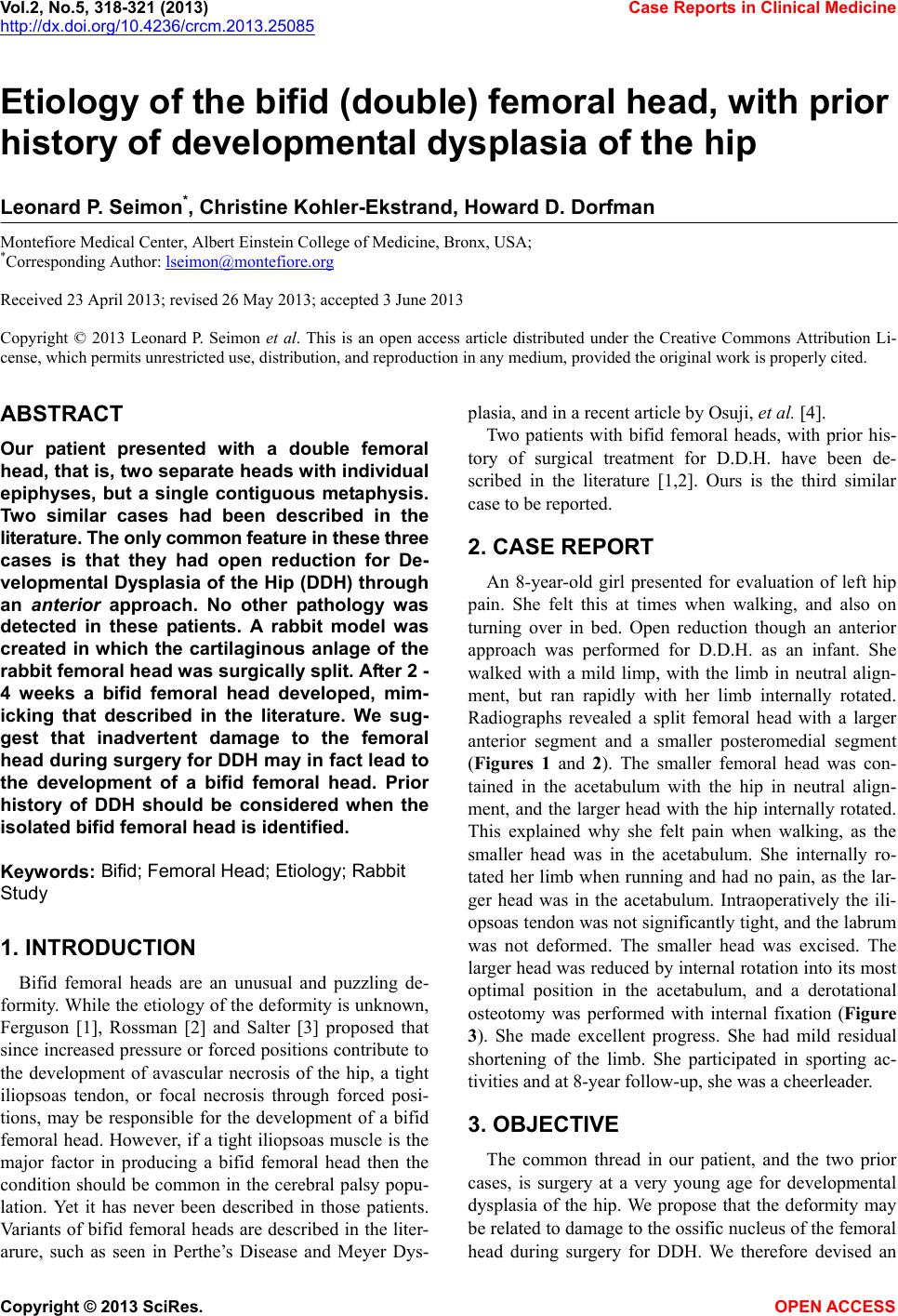
Vol.2, No.5, 318-321 (2013) Case Reports in Clinical Medicine
http://dx.doi.org/10.4236/crcm.2013.25085
Etiology of the bifid (double) femoral head, with prior
history of developmental dysplasia of the hip
Leonard P. Seimon*, Christine Kohler-Ekstrand, Howard D. Dorfman
Montefiore Medical Center, Albert Einstein College of Medicine, Bronx, USA;
*Corresponding Author: lseimon@montefiore.org
Received 23 April 2013; revised 26 May 2013; accepted 3 June 2013
Copyright © 2013 Leonard P. Seimon et al. This is an open access article distributed under the Creative Commons Attribution Li-
cense, which permits unrestricted use, distribution, and reproduction in any medium, provided the original work is properly cited.
ABSTRACT
Our patient presented with a double femoral
head, that is, two separate heads with individual
epiphyses, but a single contiguous metaphysis.
Two similar cases had been described in the
literature. The only common feature in these three
cases is that they had open reduction for De-
velopmental Dysplasia of the Hip (DDH) through
an anterior approach. No other pathology was
detected in these patients. A rabbit model was
created in which the cartilaginous anlage of the
rabbit femoral head was surgically split. After 2 -
4 weeks a bifid femoral head developed, mim-
icking that described in the literature. We sug-
gest that inadvertent damage to the femoral
head during surgery for DDH may in fact lead to
the development of a bifid femoral head. Prior
history of DDH should be considered when the
isolated bifid femoral head is identified.
Keywords: Bifid; Femoral Head; Etiology; Rabbit
Study
1. INTRODUCTION
Bifid femoral heads are an unusual and puzzling de-
formity. While the etiology of the deformity is unknown,
Ferguson [1], Rossman [2] and Salter [3] proposed that
since increased pressure or forced positions contribute to
the development of avascular necrosis of the hip, a tight
iliopsoas tendon, or focal necrosis through forced posi-
tions, may be responsible for the development of a bifid
femoral head. However, if a tight iliopsoas muscle is the
major factor in producing a bifid femoral head then the
condition should be common in the cerebral palsy popu-
lation. Yet it has never been described in those patients.
Variants of bifid femoral heads are described in the liter-
arure, such as seen in Perthe’s Disease and Meyer Dys-
plasia, and in a recent article by Osuji, et al. [4].
Two patients with bifid femoral heads, with prior his-
tory of surgical treatment for D.D.H. have been de-
scribed in the literature [1,2]. Ours is the third similar
case to be reported.
2. CASE REPORT
An 8-year-old girl presented for evaluation of left hip
pain. She felt this at times when walking, and also on
turning over in bed. Open reduction though an anterior
approach was performed for D.D.H. as an infant. She
walked with a mild limp, with the limb in neutral align-
ment, but ran rapidly with her limb internally rotated.
Radiographs revealed a split femoral head with a larger
anterior segment and a smaller posteromedial segment
(Figures 1 and 2). The smaller femoral head was con-
tained in the acetabulum with the hip in neutral align-
ment, and the larger head with the hip internally rotated.
This explained why she felt pain when walking, as the
smaller head was in the acetabulum. She internally ro-
tated her limb when running and had no pain, as the lar-
ger head was in the acetabulum. Intraoperatively the ili-
opsoas tendon was not significantly tight, and the labrum
was not deformed. The smaller head was excised. The
larger head was reduced by internal rotation into its most
optimal position in the acetabulum, and a derotational
osteotomy was performed with internal fixation (Figure
3). She made excellent progress. She had mild residual
shortening of the limb. She participated in sporting ac-
tivities and at 8-year follow-up, she was a cheerleader.
3. OBJECTIVE
The common thread in our patient, and the two prior
cases, is surgery at a very young age for developmental
dysplasia of the hip. We propose that the deformity may
be related to damage to the ossific nucleus of the femoral
head during surgery for DDH. We therefore devised an
Copyright © 2013 SciRes. OPEN A CCESS